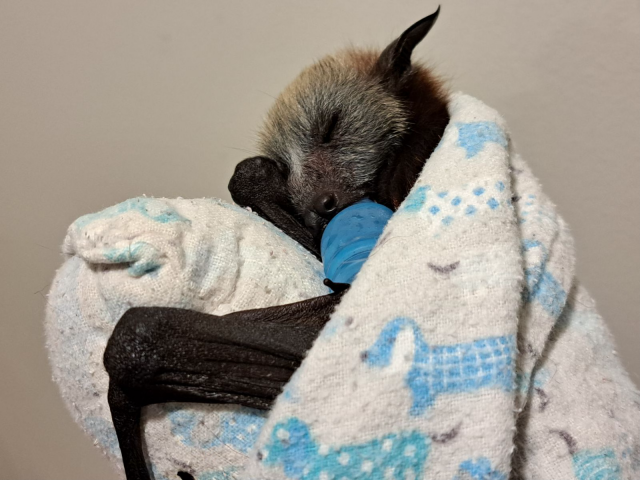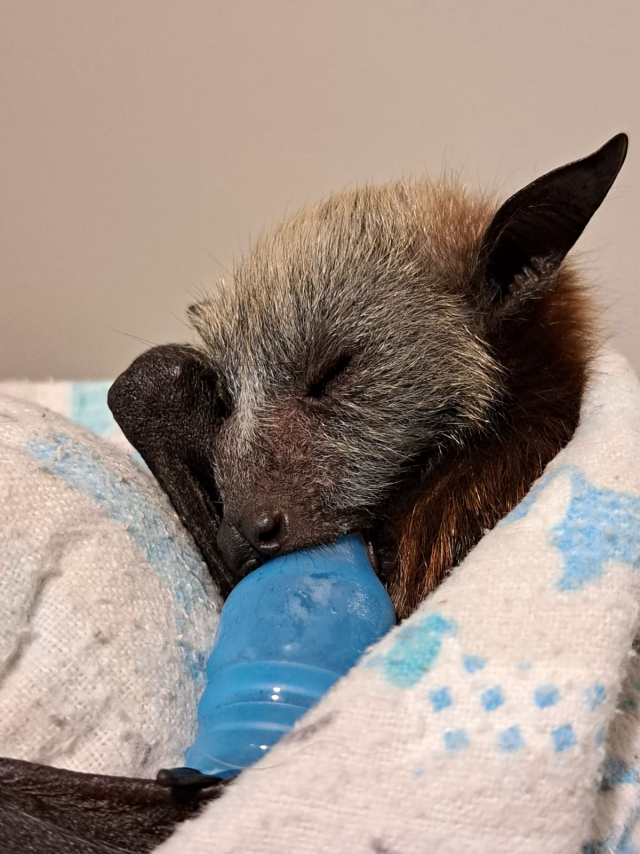One of the Hills’ smallest residents has been rescued from a trying situation, with others in need of locals’ help.
A young grey-headed flying fox, or pup, has been rehomed at Bungalook Creek Wildlife Shelter after being rescued from his mother, who was electrocuted on the power line they were found hanging on in Ferntree Gully.
A Ferntree Gully resident noticed the pups’ mother hanging from the powerline and called it into the Shelter, not knowing the young bat – who has been named Arlo – was tucked into her wing at the time she was fatally electrocuted.
Bungalook Creek’s Emma Cash was the person who came to his rescue, with the assistance of a local power company, to carefully bring the mother and her pup to safety.
She said when she went to retrieve the mother, Arlo was hard to see, and is often the case in those situations.
“It really took a while to see the pup through binoculars.
“Someone who hasn’t seen a pup with its mother before might not even realise they are up there,” she said.
Ms Cash said with the weather patterns bringing several ups and downs, combined with the blossoming of trees – gum trees in particular – are bringing bats closer to power lines in the Hills area, and closer to danger.
“When a bat makes two points of contact on power lines it can lead to electrocution.
“It isn’t always fatal, but it can be.
“Pups tend to miss the charge when they’re tucked in with mum, which is why they tend to survive, even if their mothers don’t.
“Arlo’s mum may have been feeding on the flowering gum close to the powerline, and for some reason has come across and hit it with both of the thumbs on her wings, and those connections are what caused her electrocution,” she said.
Ms Cash said the biggest advice she could give to locals is to look up, and if they see a bat caught on a power line, not to go near it and call a rescue group.
“We have specific vaccines against diseases that the bats might be carrying, and ask locals not to touch the bats.
“If they’re exposed in the sun, or if it’s been wet, and you can safely cover the bat to protect it from the elements and pests with a blanket or towel without touching them, that is also helpful,” she said.
When Arlo was rescued, Ms Cash said the power company was skillful in ensuring he had a smooth descent to the ground, and was then wrapped up in a momma roll with a dummy to imitate him still being attached to his mother.
“When we got to him, he had cooled down a lot from the wet and cold weather we’ve had, so we had to get him warm as quickly as possible and get him back to the shelter,” she said.
Ms Creek Arlo is now safely at the Bungalook Creek Wildlife Shelter, being fed on specialised formula and integrated with his new siblings.
“We had another rescue just after Arlo who was found on the ground, so now Arlo has a little brother to grow up with.
She said grey-headed flying foxes are very social creatures, who do better growing up with other bats around.
“These rescued pups will stay with us for the next 18 weeks as they grow up, learning to be bats.
“It’s good they have siblings to squabble with and learn from as they grow up.
“Once they reach 18 weeks with us, we take them to a bat crate with other baby bats in the area for a few more weeks to learn survival skills together and how to be a big bat, learning social structures, feeding and survival skills and make friends with the other bats.
“Then we integrate them out into one of the main colonies and back into the wild population,” she said.
Ms Cash said this way, the bats get used to being around other bats, and tend to stay away from people when they are reintegrated into the wild.
She urges locals in the Hills area to look up, and call in any bats they see caught in power lines in the community.
Ms Cash also said for those with fruit trees on their property who don’t wish to share it with bats, to use very small netting over their trees.
“If you can fit your finger through the holes, it’s too large.
“Even better, if locals want to buy branch sleeves, and share the rest of their trees with the native wildlife that also resides in the Hills,” she said.









